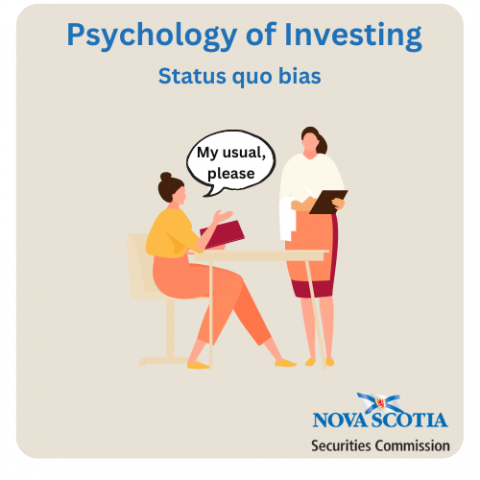Submitted by nsscadmin on

The seventh part of our psychology of investing series takes a closer look at status quo bias. How comfortable are you with change? Most people don’t like change, some even fear it. If you prefer to stick to the ways things are instead of changing course, even when the change might be wise, you could be affected by status quo bias.
Even people who aren’t heavily influenced by status quo bias may have trouble with change. Many people faced with a decision will stick with the status quo because: it can save time, energy, and frankly it’s often just easier. If you are influenced by status quo bias, you will likely need a very strong motivation or incentive to make a change.
A few places that status quo bias can show up in our lives include restaurant and food choice, and preferences, and election results. When you visit your favourite restaurant you may stick to your usual meal or something close to that instead of trying something new and different. The same can be said when you are filling your cart at the grocery store. When it comes to elections, incumbents are often more likely to win than new challengers. There was a lot of changes in the most recent Canadian Federal election but still nearly 200 incumbents were voted back in compared to only 44 incumbents who lost their re-election bids.
When it comes to personal finance and investing, status quo bias can often impact your ability to change financial products and the investment decisions you make over the short and long terms.
When it comes to financial products, we are referring to everything from credit cards, and saving accounts, to your mortgage. In many cases people influenced by status quo bias will stick with the same credit card, accounts, or mortgage broker despite the fact that making a change may provide them with better interest rates, lower fees, or other financial advantages. (Of course, service providers may also contribute to the challenges of making such a change, but that is a topic for another post.)
When it comes to investment decisions status quo bias can make investors reluctant to make changes to their investment portfolio. This could lead to an unbalanced portfolio, holding investments that may no longer be suitable for them and their goals, or sticking to a single asset class instead of diversifying.
If status quo bias has caused you to make poor investment decisions in the past or you believe you are susceptible to status quo bias, here are a few ways to protect yourself when investing.
Consider the opposite approach – People affected by status quo bias often avoid change by focusing on the benefits of what they’re already doing. To determine if a change may be the right decision instead reframe your focus by looking at the potential benefits of making a change.
Ask an expert – If you’re avoiding making any changes in your investment portfolio, get help from an expert like a registered financial adviser. An outside unbiased view from an expert may help point out beneficial investment changes and give you the confidence and information needed to move away from the status quo.
Look at objective data – People often avoid change because they want to stick to the familiar and worry about regret that may come from making changes. Strengthen your resolve to make a change by finding strong objective data that can support and motivate this change. (This may also require you to overcome your confirmation bias, which is a topic we have covered previously.)
Our series on the psychology of investing continues in two weeks with Part 8 which looks at status present bias.
